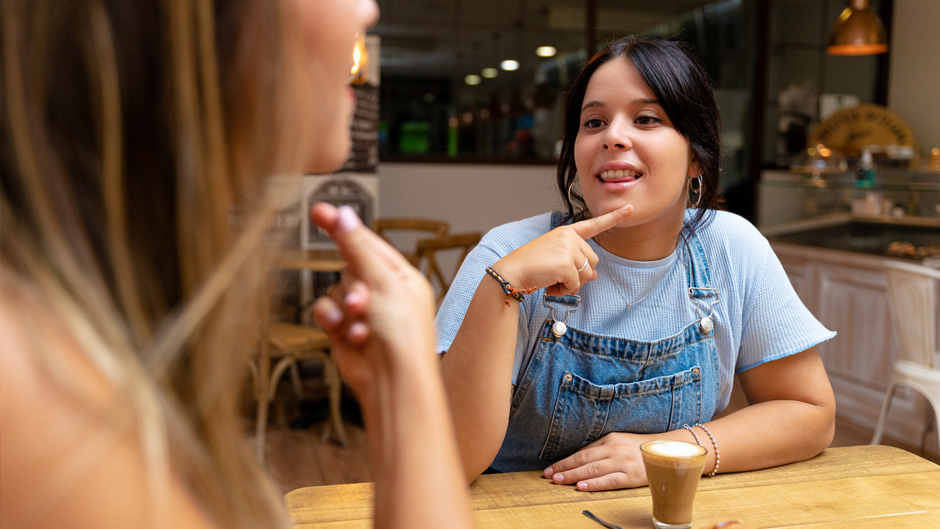The Academy Award-winning film "CODA" (Child of Deaf Adults) serves as the most recent and riveting example of media and popular culture embracing—in refreshingly honest fashion—the Deaf community and its culture, according to Kirsten Schwarz, a lecturer in the Teaching and Learning Department in the University of Miami School of Education and Human Development.
“The movie has been huge for people realizing what it’s like to be deaf and appreciating that perspective,” said Schwarz, who is currently completing her doctorate in speech-language pathology. “We’ve seen a huge shift in the media in last four or five years, and 'CODA' accentuated that, showing people who are deaf in real life situations and in so many powerful moments in the film.”
Schwarz, who serves as the advisor for the American Sign Language (ASL) Club and teaches the sequence of ASL classes, highlighted increased interest in the Deaf community at the University, as well. This fall, a new minor for both ASL and one for Disabilities and Society will be offered for the first time, and the ASL Club has seen a boost in its membership.
“Previously the club was a lot of education majors, psychology students, and a ton of premed students, but now it’s really built out and membership is more diverse,” she noted.
In the club and in the coursework, students learn to appreciate the challenges—for securing employment, dating, and communicating in general—of the Deaf community and other populations with disabilities.
Fatima Navarro, a sophomore, took the first two ASL courses, joined the club and served as its events chair last year.
Navarro, who has experience as a Spanish-English translator and interpreter for election campaigns in her Chicago community, was motivated to learn sign language and learn about Deaf culture after an experience where an ASL interpreter was needed—but none was available.
One of her biggest learning moments during the year was how similar the deaf are to people without disabilities.
“There’s a sense of exclusion of the Deaf community. Everyone treats it as if it’s an abnormality or distant language gap—and they’re actually just like everyone else and are able to live just as we do with the exception of the hearing,” Navarro commented.
As events coordinator, Navarro helped strengthen the club’s partnership through interactions with South Plantation High School and its group of deaf students. University ASL club members hosted the high schoolers to attend a ’Canes basketball game and observed that the students were very independent.
Schwarz emphasized Navarro’s recognition of commonalities.
“We have much more in common with the deaf than we have differences,” she said. “They can still drive, work, have children, and we have a lot of those discussions in our class.”
The exchanges also help remedy other misperceptions about the deaf, advance awareness of what people who are deaf can do, and demonstrate how innovations—vibrating mattress and pillow pads for waking up and flashing lights for fire alarms and the cell phone—are empowering the Deaf community, according to Schwarz.
Yet learning ASL, a complete and organized language that is solely visual, poses unique challenges.
“With signing, there’s a lot that’s lost in translation, and with ASL we often use the expression ‘you’ve missed the boat’ or ‘the train left’—meaning that the signing isn’t permanent. You sign it and then it disappears,” Schwarz explained.
Idioms and the many new expressions stemming from popular culture that seep into the spoken language create difficulties for signers.
“Sometimes the interpreters sign an expression too literally, such as ‘I’ve got butterflies in my stomach,’ which of course means ‘I’m nervous or anxious,’ ” she said. “If an interpreter signs ‘I ate a butterfly,’ well, that will leave the deaf person wondering ‘you did what?’ ’’ Still, just as with English, social media terms, argot, and other contemporary parlance are quickly absorbed to become part of the ASL lexicon.
Schwarz noted that the structure of ASL differs significantly from English and is grammatically more akin to French, the language from which signing evolved and the country from which much of our understanding of the deaf emanated because of Thomas Gallaudet. The U.S. educator traveled to France in the early 1800s to study methods for teaching the deaf and later inspired a movement that enhanced understanding of and services for the deaf in this country, including the founding of Gallaudet University, the world’s only university for the deaf and hard of hearing.
“And you have to use nonverbal communication,” she emphasized. “If you’re signing ‘happy,’ that happy face has to go with it. If ‘yes,’ then the head nod. If you’re asking a question, you have to lean forward, put on that puzzled face, and let them know you’re waiting for a response.”
In addition to serving as the ASL Club’s advisor, Schwarz coordinates the training of faculty and staff members during the University’s “Disabilities in the Workplace Awareness Month.” Held typically in the fall, it is a time when awareness and sensitivity for those with disabilities takes center stage.
“We strive to help others understand what it means to have a disability,” she explained. “We talk about people-first language—something that people fought for, for so long—even though some with disabilities themselves even resist those references,” Schwarz added.
“One of the things that I emphasize is that there is variation within the Deaf community and that you should treat each person as an individual . . . and ask what treatments and approaches they prefer,” she continued. “The open conversations are essential. And the more we have them as part of the trainings and in our ASL classes, the more we create understanding and empathy even within our own community.”
The Office of Disability Services, located in the Camner Center for Academic Resources, coordinates resources for the Deaf community at the University.

